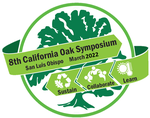#9

Conifer Encroachment and Removal in a Northern California Oak Woodland: Influences on Ecosystem Physiology and Biodiversity
Gabriel Goff, Dept. of Forestry, Cal Poly Humboldt, Arcata
*Lucy Kerhoulas, Dept. of Forestry, Cal Poly Humboldt, Arcata
Nicholas Kerhoulas, Dept. of Forestry and Dept. of Wildlife, Cal Poly Humboldt; Jill Beckmann, School of Forestry, Northern Arizona University; Jeffrey Kane, Dept. of Forestry, Fire, & Rangeland Management, Cal Poly Humboldt; Rosemary Sheriff, Dept. of Geography, Environment, & Spatial Analysis, Cal Poly Humboldt
Fire suppression since the colonization of western America by Europeans has induced landscape-level changes, altering species composition and disrupting traditional successional processes. Oregon white oak (Quercus garryana) woodlands across their range are becoming increasingly threatened by encroaching Douglas-fir (Pseudotsuga menziesii) as a result of fire suppression, expanding landscape homogeneity, threatening biodiversity, and degrading important cultural spaces. Although previous research has investigated oak woodland responses to conifer encroachment and subsequent thinning treatments, few studies have evaluated these responses using physiology and biodiversity metrics in tandem to paint a larger, more complex picture. Using stem-level water potential (Ψ) and stomatal conductance (Gs), this study investigates the physiological effects of conifer encroachment and subsequent removal.
Pre-treatment physiology results suggest that Ψ was highest in open sites, indicating that water availability was the most limiting factor on these sites. Our findings also suggest that on open and moderately encroached sites Gs and Ψ displayed a negative relationship, indicating that these sites are water limited. On heavily encroached sites, Gs and Ψ exhibited a positive relationship where net photosynthesis increased as the trees became more water stressed. These results suggest that heavily encroached sites are light limited environments where increased water stress is likely due to high live crowns competing with conifers. Although conifer shade prolonged stand water availability, it significantly reduced oak productivity early in the growing season, a crucial time for rapid and vigorous growth. Heavy conifer encroachment also significantly reduced understory plant diversity, but increased bird diversity. As such, we conclude that conifer encroachment reduces oak woodland vigor via shading and loss of plant diversity and recommend further long-term monitoring of ecosystem responses to restoration.
